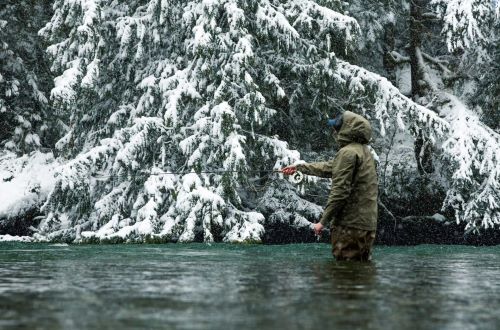With the onset of warmer spring weather in northern B.C., many anglers will begin to anticipate and welcome a short but sweet steelhead season that’s like no other on this planet. While many avid steelhead anglers are familiar with this destination’s catch-and-release bounty of summer- and fall-run steelhead on the fly, less well-known is the spring-run fishery.
These later, spring-migrating steelhead have a precise time of entry to the fabled waters of the lower Skeena watershed. Too early in the season, heavy ice flows and low water limit upstream migration; later, the high water flows of the spring freshet present an inevitable battle. The fish clue in to the perfect time between these extremes to move to their spawning grounds.
Though timing really is everything to find these fish, and a game of chance for visiting anglers, the reward can be spectacular. Folks willing to brave the elements in this large, glacially carved river valley should be prepared for big fish that are carrying all their marine weight from offshore feeding grounds. Ocean-fresh steelhead – extremely aggressive to the fly – make for a short but tremendous angling season.
Clothing and Gear
Spring weather can be more forgiving than deep winter, but it’s still best to dress for conditions that might change rapidly for the worse. It’s always nicer to remove a layer than to wish you had packed an extra one. Start with moisture-wicking thermal underwear, then put on thin, warm layers, and end with a totally weatherproof outer jacket made of breathable material. Two pairs of thermal socks are going to be your best friends during long days on the water, and always be sure to check – before leaving home – that your waders are free of any leaks. It never hurts to have a pair of waterproof fishing gloves, but always remember, the fish comes first. “Keep ’em wet” and remove your gloves before handling your catch. There are many great choices of clothing on the market whose design doesn’t interfere with casting.

The steelhead angler will be well-suited with 8- to 9-weight Spey fly rods with matching large-arbor fly reels. While a longer Spey rod is ideal, a shorter switch fly rod can bridge the gap between conventional overhead casting and Spey techniques. For the kind of fly-fishing we’re mainly dealing with, shorter Skagit-type, shooting head fly lines are very easy to cast, versatile in application, and have the ability to cast a plethora of sink-tips, large flies, and skated dry flies that will suit the runs and water conditions.
For flies, select a well-dressed steelhead pattern that you are confident of presenting well to fish. During this time of year, the trend does seem to lean towards pink or orange fly patterns, but black ones work as well, and all should prove successful in provoking steelhead to strike.
Techniques and Approach
Due to the short window when water conditions are ideal for steelhead to spawn successfully, spring steelhead in the Skeena River tend to move quite briskly along their migration route. Anglers will find that the majority of fish hold in the shallower water with slower, milder flows located just inside the seam between it and the fastest-moving water of the river’s main current. These fish-holding spots, referred to as “brief” or “temporary” lies, are often fairly close to shore, and may only be 45 to 60 centimetres (1.5 to two feet) deep. Try not to step or cast over these fish: obey the maxim “keep your knees dry, and your fly wet.” That is, wade shallowly, and make only modestly long casts.
Flies should be offered as if presenting a dry pattern on a dry fly line: cast across the current, and let your fly drift at almost right angles to the current. This will allow fish to see the whole broad profile of your offering, analyze the presentation, and aggressively strike. As your fly will be swung through fairly shallow riffles for the most part, lighter sink-tips should be used as well. For the angler looking to experience the ultimate in fly-fishing for steelhead, try fishing a dry fly in the same manner.
Spring may be one of the more challenging seasons to fish for steelhead on the Skeena, but these fish are worth the effort. It’s a great way to spend some time on open, flowing water after a long season when everything has been frozen over.
Keep in mind, many Lower Skeena tributaries may require a classified waters licence. Remember to consult your freshwater fishing regulations before heading out. Be sure that you are aware of any in-season changes crucial to ensuring a healthy future for northern B.C.’s pristine fisheries.
“Tight Lines, Folks!”
Author: Jonathan Riddell
Photo Credit: Jonathan Riddell and N. Te
Jonathan works as a freelance photographer, specializing in fly-fishing imagery from various fishing outfits and lodges in British Columbia. When not documenting clients’ outdoor activities, he spends all of his time swinging flies for wild steelhead, casting dry flies to trout in remote lakes, or spinning up fly patterns for a local fly shop. Growing up on Vancouver Island, and residing in Terrace, B.C., has allowed Jon ample opportunities to fulfill his outdoor dreams.
Follow Jonathan on Instagram and Facebook
